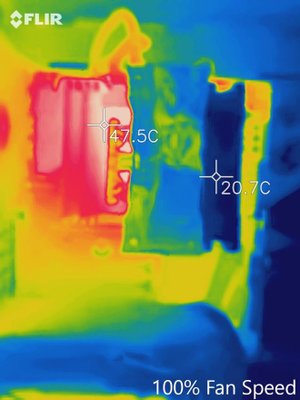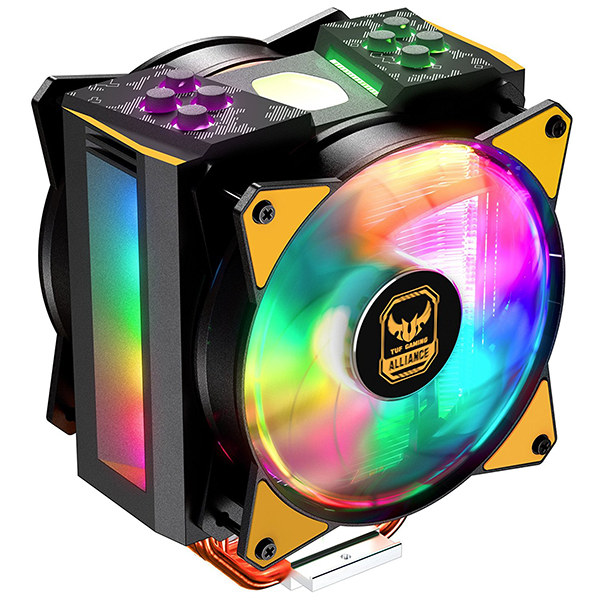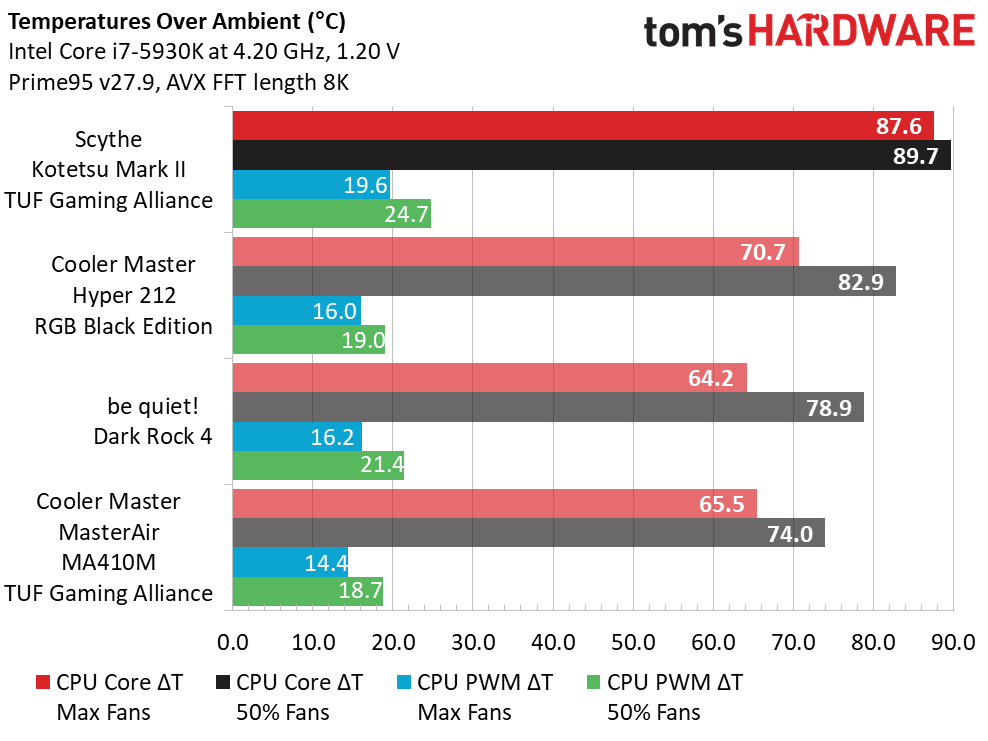Scythe Kotetsu Mark II TUF Gaming Alliance Cooler Review
Why you can trust Tom's Hardware
Testing Results and Conclusion
Our comparison tests are derived from current and prior CPU cooler testing using standardized methods for benchmarking and gathering data on our hex-core, Core i7-5930K running at 4.2 GHz. We will be comparing the Scythe Kotetsu MkII TUF Gaming Alliance with the Cooler Master Hyper 212 RGB Black, the be quiet! Dark Rock 4 and Cooler Master MasterAir MA410M TUF Gaming Edition.
The reason we’ve stuck with our 5930K primarily is because it’s quite good at what it does: generating a lot of heat with great consistency when heavily loaded. Its fixed clock was designed to push the absolute limits of 120mm single-fan/single-tower coolers and adequately prove the performance advantages of larger units.
Thermal loads from our mini-blast-furnace i7-5930K CPU nearly overloads the Scythe Kotetsu Mark II cooler at both full and half speed fan settings. There’s just no other way to say it, but the Kotetsu Mark II cooling performance is entry-level at best, at least by our test standards.
Looking at the thermal load charts against the fan speed chart, the Scythe Kotetsu Mark II fan speed does happen to be the lowest of the comparison group, its 100 percent setting hovering just barely above the 50% speeds turned in by both Cooler Master products. The fan on the be quiet! Dark Rock 4’s low RPM value happens to be from a 135 mm model, while all other fans in the testing group are 120 mm diameter.
Those moderate fan speeds from the Kotetsu MarK II make a big difference in terms of ambient noise levels, sliding in just barely above the whisper-silent Dark Rock 4. By comparison, the twin-turbine Cooler Master MA410M TUF is a deafening shuttle launch.
Factoring cooling performance with noise levels, the Kotetsu Mark II doesn’t fare as well despite its great acoustics. The inverse is exactly true for the MasterAir MA410M TUF with good cooling performance and worst registered noise levels.
Flash forward to the performance value chart where the Kotetsu makes a sweeping charge to finish out relatively strong for the testing group, primarily due to its very friendly $40 (£31) price point. While the Dark Rock 4 and MA410M do perform much better in thermal and acoustic tests, pricing equalizes the playing field when all points are used for comparison.
Get Tom's Hardware's best news and in-depth reviews, straight to your inbox.


Thermal imaging from our Flir One Pro show a relative heat bloom at 50 percent fan speed as compared to full speed, although not as much of a difference as we’d expect considering the reported core temperatures. This could point to something more fundamental with how the heatpipes are able to absorb loads from the CPU and dissipate effectively through the cooling tower fins. Otherwise, we’d see a definitive spike in thermals in the cooling tower, indicating that the Kotetsu’s fan isn’t up to snuff.
Scythe’s Kotetsu Mark II TUF Gaming Alliance cooler leaves us with some debate, though. On one hand, it performs rather poorly under high loads from our overclocked six-core i7-5930K. While it could be argued that many current-gen 4-8 core CPUs won’t likely be pushing TDPs nearly as high, we still must consider all possibilities are indeed, possible.
On the other hand, the handsomely low price of $40 (£31) makes it very attractive to budget system builders and entry level overclockers. In addition, the TUF Gaming Alliance theme adds a bit of aesthetic allure to that that as well. Low costs often play very well into what many budget gamers are looking for, although the Cooler Master Hyper 212 RGB black performs better and offers an included RGB controller, while also being priced the same as the Scythe Kotetsu Mark II TUF Gaming Alliance.
The Kotetsu looks to be a solid fit for the budget gaming community, which is a bona fide commitment, considering the number of builds going online these days with four cores or fewer onboard. But we wish it offered an RGB controller, better HEDT performance or a lower price.
Want to comment on this story? Let us know what you think in the Tom's Hardware Forums.
MORE: Best CPU Cooling
MORE: How To Choose A CPU Cooler
MORE: All Cooling Content

Garrett Carver is a contributor for Tom’s Hardware, primarily covering thermal compound comparisons and CPU cooling reviews; both air and liquid, including multiple variations of each.







